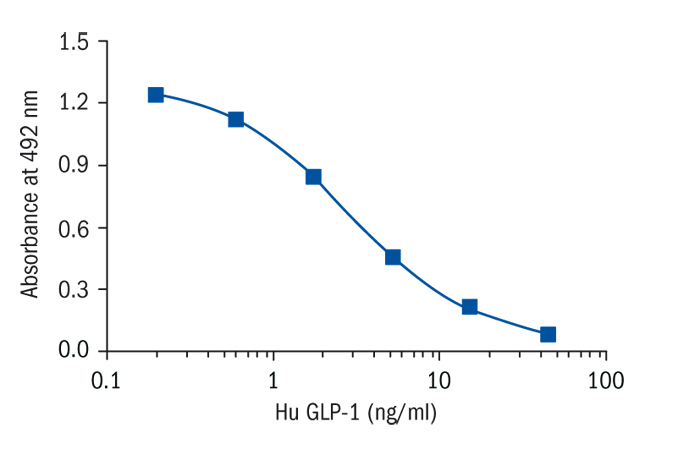Cat # changed from RSCYK160R to YK160
Type
Competitive ELISA
Description
This EIA kit is used for quantitative determination of rat/mouse/human GLP-1 in plasma samples.
The kit is characterized by sensitive quantification and high specificity. In addition , it is not influenced
by the other constituents in samples. GLP-1 standard of this kit is a highly purified synthetic product.
Applications
Plasma
Sample Requirements
30 μL
Shipping
On blue ice packs. Upon receipt, store the product at the temperature recommended below.
Storage/Expiration
Store the complete kit at 2–8°C. Under these conditions, the kit is stable until the expiration date (see label on the box).
Calibration Curve
Calibration Range
0.206-50 ng/mL
Limit of Detection
0.206 ng/ml
Intra-assay (Within-Run)
Rat plasma - CV 5.36 - 6.60
Human plasma - CV 4.69 - 10.67
Inter-assay (Run-to-Run)
Rat plasma - CV 5.51 -18.87
Human plasma - CV 9.63 - 17.57
Spiking Recovery
Rat plasma 89.2 - 110,4%
Human plasma 86-101.7%
Specificity
This EIA kit has h
igh specificity to rat/mouse/human GLP-1 and shows crossreactivity neither
rat/human/mouse glucagons , human glicentin nor rat/mouse/human GLP-2.
Features
- RUO
- assay range: 0.206-50 ng/mL
- the assay is completed within 16-18 hr.+1.5 hr.
- with one assay kit, 41 samples can be measured in duplicate
- test sample: plasma (rat/mouse/human)
Research topic
Diabetology - Other Relevant Products, Energy metabolism and body weight regulation, Animal studies
Summary
GLP-1 is a peptide hormone from the intestinal mucosa, which is produced from its precursor, proglucagon by post transnational processing. The mammalian proglucagon 1) is synthesized in the neuroendocrine L-cell of the intestine and the alpha-cells of the pancreas. It contains within its structure the sequences of glucagon and two glucagon-like peptides (GLP-1 and GLP-2) in tandem flanked at their amino and carboxyl termini by dibasic residues. GLP-1 is a 37 amino acids peptide and produced in the small intestine and in the pancreas in the human, in either C-terminal-amidated on glycine-extended form2) 3). GLP1 (7-36) amide and its receptor are present in several brain regions and may play a role in the physiological control of feeding4). Several reports have been presented as follows as to the biological activities of GLP-1. GLP-1 (7-37) and (7-36) amide is known as one of the most potent insulin secretagogues 5). GLP-1 (7-36) amide was supposed to improved glycemic control in patients with type 2 diabetes by increasing insulin secretion, by inhibiting glucagon secretion and by delaying gastric emptying rather than by altering extrapancreatic glucose metabolism6). Intravenous GLP-1 (7-37) and (7-36) amide could normalize fasting hyperglycaemia in type 2 diabetic patients7). Hyperglycaemia during parenteral nutrition could be controlled by exogenous GLP-1, whereas the chronic therapy of type 2 diabetes required GLP-1 derivatives with longer duration of action 8). Recombinant GLP-1 (7-36) amide was recently shown to cause significant weight loss in type 2 diabetics when administered for 6 weeks as a continuous subcutaneous infusion, 5-day treatment of hereby obese human subjects with GLP-1 at high doses by prandial subcutaneous infusion promptly slowed gastric emptying as a probable mechanism of action of increased satiety, decreased hunger and reduced food intake with an ensuing weight loss9). A G-protein-coupled receptor, GPR120, which is abundantly expressed in intestine, functions as a receptor for unsaturated long-chain FFAs (free fatty acids). The stimulation of GPR120 by FFAs promotes the secretion of GLP-1 in vitro (measured by YK160, Yanaihara Institute Inc) and in vivo, and increases circulation insulin, indicate that GPR120-mediated GLP-1 secretion induced by dietary FFAs is important in the treatment of diabetes10). All these approaches have shown remarkable efficacy in both experimental and clinical studies. The GLP-1-based therapy of type 2 diabetes, therefore, represents a new and attractive alternative11). Yanaihara Institute Inc. developed a quantitative EIA kit with high specificity and sensitivity (detection limit 0.206ng/mL) for rat/mouse/human GLP-1 (YK160) as a useful tool for these necessaries.
Instructions for Use (RUO)
Instructions for Use (RUO)
Safety Information (RUO)
MSDS (RUO)
Find documents for the lot

